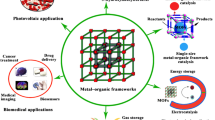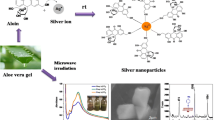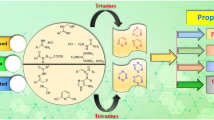Abstract
Four novel N-aryl maleimide-bearing aromatic 1,3,4-oxadiazole systems were synthesized via a thermally induced cyclodehydration reaction of their corresponding precursors maleimido aromatic hydrazide derivatives. Their chemical structures were confirmed by elemental analyses, FTIR, 1H-NMR and mass spectroscopy. They showed a good antimicrobial activity against Bacillus subtilis, Streptococcus pneumoniae, Escherichia coli, Aspergillus fumigatus, Geotrichum candidum and Syncephalastrum racemosum using agar well diffusion method. The investigated derivatives are thermally stable and start decomposition in the temperature range above 250–300 °C. They were investigated for thermal stabilization of rigid PVC using thermogravimetric analysis technique, in nitrogen. They showed a greater stabilizing efficiency as illustrated by their higher initial decomposition temperature and higher residual mass percent at particular temperatures relative to dibasic lead carbonate, cadmium–barium–zinc stearate complex and di-n-octyltin bis (isooctylmercaptoacetate) (n-octyltin mercaptide, n-OTM) reference thermal stabilizers. Their stabilizing efficiency is also demonstrated by lower rates of both discoloration and degree of chain scission of the polymer during degradation. The electron-donating substituent groups in the aromatic ring of 1,3,4-oxadiazole part of these derivatives increased their stabilizing efficiency.





Similar content being viewed by others
References
Starnes WH Jr. Structural and mechanistic aspects of the thermal degradation of poly (vinyl chloride). Prog Polym Sci. 2002;27:2133–70.
Starnes WH Jr, Ge X. Mechanism of autocatalysis in the thermal dehydrochlorination of poly(vinyl chloride). Macromolecules. 2004;37:352–9.
Qi Y, Wu W, Han L, Qu H, Han X, Wang A, Xu J. Using TG-FTIR and XPS to understand thermal degradation and flame-retardant mechanism of flexible poly(vinyl chloride) filled with metallic ferrites. J Therm Anal Calorim. 2016;123:1263–71.
Jakić M, Vrandečić NS, Erceg M. Kinetic analysis of the non-isothermal degradation of poly(vinyl chloride)/poly(ethylene oxide) blends. J Therm Anal Calorim. 2016;123:1513–22.
Jakić M, Vrandečić NS, Erceg M. The influence of poly(ethylene glycol) on thermal properties of poly(vinyl chloride)/poly(ethylene oxide) blends. J Therm Anal Calorim. 2017;127:663–74.
Starnes WH Jr. Structural defects in poly(vinyl chloride). J Polym Sci, Part A: Polym Chem. 2005;43:2451–67.
Starnes WH Jr. Overview and assessment of recent research on the structural defects in poly(vinyl chloride). Polym Degrad Stab. 2012;97:1815–21.
Yu J, Sun L, Ma C, Qiao Y, Yao H. Thermal degradation of PVC: a review. Waste Manag. 2016;48:300–14.
Fahmy MM. Inhibition of the thermal degradation of rigid poly(vinyl chloride) using poly(N-[4-(N’-phenylaminocarbonyl)phenyl]maleimide). J Appl Polym Sci. 2010;115:2013–8.
Mohamed NA, Al-Magribi WM. N-(Substituted phenyl) itaconimides as organic stabilizers for rigid poly(vinyl chloride) against thermal degradation. Polym Degrad Stab. 2002;78:149–65.
Mohamed NA, Farag ZR, Sabaa MW. Thermal degradation behavior of poly(vinyl chloride) in presense of poly(N-acryloyl-N’-cyanoacetohydrazide). J Appl Polym Sci. 2008;109:2362–8.
Shnawa HA, Jahani Y, Khalaf MN, Taobi AH. The potential of tannins as thermal co-stabilizer additive for polyvinyl chloride. J Therm Anal Calorim. 2016;123:1253–61.
Folarin OM, Sadiku ER. Thermal stabilizers for poly(vinyl chloride): a review. Int J Phys Sci. 2011;6:4323–30.
Wypych G. PVC degradation & stabilization. 2nd ed. Toronto: ChemTec Publishing; 2008. p. 295–335.
Shnawa HA. Thermal stabilization of polyvinyl chloride with traditional and naturally derived antioxidant and thermal stabilizer synthesized from tannins. J Therm Anal Calorim. 2017;129:789–99.
Mohamed NA, Abd El-Ghany NA, Fahmy MM, Ahmed MH. Thermally stable antimicrobial PVC/maleimido phenyl thiourea composites. Adv Polym Technol. 2016;35:21537–46.
Fahmy MM, Mohamed RR, Mohamed NA. Novel antimicrobial organic thermal stabilizer and co-stabilizer for rigid PVC. Molecules. 2012;17:7927–40.
Xu X, Chen S, Shi Y, Wu B, Ma M, Wang X. Novel organic antibacterial thermal stabilizers for transparent poly(vinyl chloride). J Therm Anal Calorim. 2015;122:1435–44.
Pereiva ER, Fabre S, Sancelme M. Antimicrobial activities of indolocarbazole and bis-indole protein kinase C inhibitors. II. Substitution on maleimde nitrogen with functional groups bearing a labile hydrogen. J Antibiot. 1995;48:863–8.
Salewska N, Boros-Majewska J, Łącka I, Chylińska K, Sabisz M, Milewski S, Milewska MJ. Chemical reactivity and antimicrobial activity of N-substituted maleimides. J Enzyme Inhib Med Chem. 2012;27:117–24.
Chin TS, Nasir FI, Hassan NI. Synthesis and antimicrobial activities of eleven N-substituted maleimides. Malays J Anal Sci. 2016;20:741–50.
Zentz F, Valla A, Guillou RL, Labia R, Mathot A-G, Sirot D. Synthesis and antimicrobial activities of N-substituted imides. II Farmaco. 2002;57:421–6.
Sharma S, Sharma PK, Kumar N, Dudhe R. A review: oxadiazole their chemistry and pharmacological potentials. Der Pharma Chemica. 2010;2:253–63.
El-Emam AA, Al-Deeb OA, Al-Omar M. Synthesis, antibacterial and anti-HIV activity of certain 5-(1-adamantyl)-2-substituted thio-1,3,4-oxadiazoles and 5-(1-adamantyl)-3-substituted aminomethyl-1,3,4-oxadiazolin-2-thiones. Bioorg Med Chem. 2004;12:5107–13.
Maslat AO, Abussaud M, Tashtoush H, Al-Talib M. Synthesis, antibacterial, antifungal and genotoxic activity of bis-1,3,4-oxadiazole derivatives. Pol J Pharmacol. 2002;54:55–9.
Nagalakshmi G. Synthesis, antimicrobial and anti-inflammatory activity of 2,5-disubstituted-1,3,4-oxadiazoles. Indian J Pharm Sci. 2008;70:49–55.
Khalilullah H, Ahsan MJ, Hedaitullah M, Khan S, Ahmed B. 1,3,4-oxadiazole: a biologically active scaffold. Mini Rev Med Chem. 2012;12:789–801.
Yar MS, Akhter MW. Synthesis and anticonvulsant activity of substituted oxadiazole and thiadiazole derivatives. Acta Pol Pharm. 2009;66:393–7.
Kashaw SK, Gupta V, Kashaw V, Mishra P, Stables JP, Jain NK. Anticonvulsant and sedative-hypnotic activity of some novel 3-[5-(4-substituted) phenyl-1,3,4-oxadiazole-2yl]-2-styrylquinazoline-4(3H)-ones. Med Chem Res. 2010;19:250–61.
Abu-Zaied MA, El-Telbani EM, Elgemeie GH, Nawwar GA. Synthesis and in vitro anti-tumor activity of new oxadiazole thioglycosides. Eur J Med Chem. 2011;46:229–35.
Sabaa MW, Mikhael MG, Mohamed NA, Yassin AA. N-substituted maleimides as thermal stabilizers for rigid polyvinylchloride. Die Angew Makromol Chem. 1989;168:23–35.
Mohamed NA, Al-afaleq EI. Aromatic 1,3,4-oxadiazoles as thermal stabilizers for rigid poly(vinyl chloride). Polymer. 1999;40:617–27.
Mohamed NA, Abd El-Ghany NA, Fahmy MM, Ahmed MH. Thermally stable antimicrobial poly(vinyl chloride)/maleimido aromatic hydrazide composites. J Vinyl Addit Technol. 2016;22:247–58.
Rahman A, Choudhary MI, Thompson WJ. Preparation and antimicrobial activity of some carboxymethyl chitosan acyl thiourea derivatives. Pestic Res J. 2001;16:2024–7.
Rathore HS, Mittal S, Kumar S. Synthesis, characterization and antifungal activities of 3d-transition metal complexes of 1-acetylpiperazinyldithiocarbamate, M(acpdtc)2. Pestic Res J. 2000;12:103–7.
Zhong Z, Xing R, Liu S, Wang L, Cai S, Li P. Synthesis and bioactivity of pyrazole acyl thiourea derivatives. Carbohydr Res. 2008;343:566–70.
Scott G, Tahan M, Vyvoda J. The effect of thermal processing on PVC-IV. Photo-oxidation of stabilized PVC. Eur Polym J. 1979;15:51–4.
Author information
Authors and Affiliations
Corresponding author
Rights and permissions
About this article
Cite this article
Mohamed, N.A. Biologically active maleimido aromatic 1,3,4-oxadiazole derivatives evaluated thermogravimetrically as stabilizers for rigid PVC. J Therm Anal Calorim 131, 2535–2546 (2018). https://doi.org/10.1007/s10973-017-6843-x
Received:
Accepted:
Published:
Issue Date:
DOI: https://doi.org/10.1007/s10973-017-6843-x




